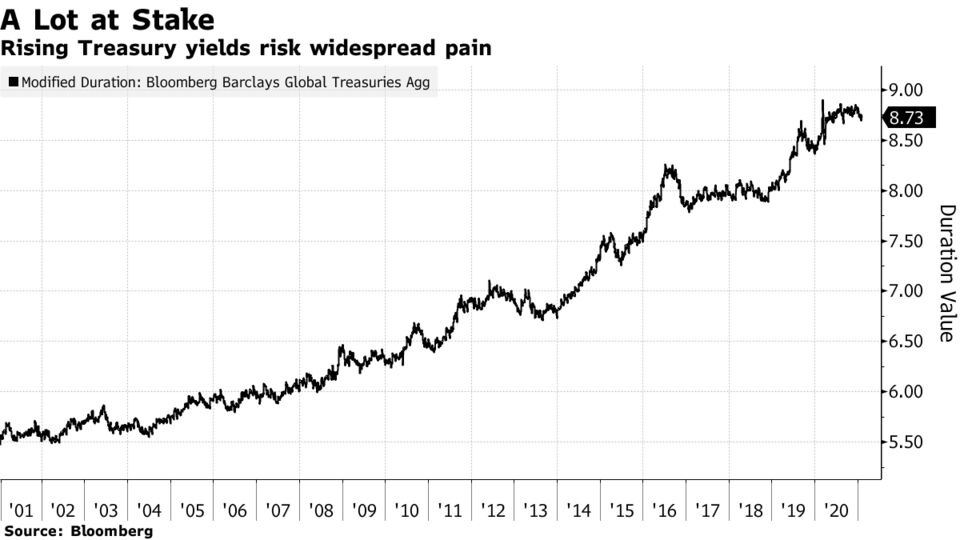Danger Lurks in Global Markets Transfixed by Rising Bond Yields
- Growth break-out would pose duration risk for stocks and bonds
- Tech firms with long-horizon cash flows are among most exposed
Just as an everything rally propels records in the S&P 500 and inflates risk assets, the bond market is emitting a warning signal to investors that a rapid economic rebound comes with its own dangers.
Treasury yields have jumped to the highest since the early days of the pandemic as the vaccine rollout and potential for another massive U.S. stimulus package revive animal spirits and the prospect of inflation. But years of near-zero rates and a historic debt overhang have left both stocks and bonds uniquely vulnerable to deep losses if yields climb too far on a growth break-out.
The risk centers on duration, now near a record as debt issuers worldwide tilt sales toward longer maturities, and coupon payments plunge or evaporate altogether. Trillions of dollars are at stake given the lofty levels in both stocks and bonds -- and some fear a repeat of the 2013 taper tantrum when then-Fed Chairman Ben Bernanke triggered a surge in yields after he suggested the central bank could begin to cut asset purchases.
“There is more duration risk embedded in the markets than many may realize,” said Gene Tannuzzo, a portfolio manager at Columbia Threadneedle.

As measures of bond duration flirt with records, investors can expect bigger losses from higher yields. It’s a risk that has wider reverberations as many equity watchers warn stocks aren’t immune, and tech darlings are particularly exposed.
Some pain is already on display. After two years of gains, the Bloomberg Barclays Global Aggregate Treasury Index has swung to a loss in 2021, with its duration holding just below a record high. Given that level and the roughly $35 trillion pile of bonds the index tracks, each percentage-point increase in yield would mean about $3 trillion of losses.
What makes things worse, says Tannuzzo, is an aspect of bond math embedded in many securities that dictates that as yields rise their duration will move higher as well. That’s mostly due to something called negative convexity -- which also means securities’ prices will fall at a greater and greater speed as rates rise.
Read moreEquity duration is a bit trickier to grasp. Some use dividend yields to calculate how many years it will take to get one’s capital back without any dividend growth, with more time equating to higher duration -- broadly speaking, a lower dividend rate means a higher duration.
Vulnerable Techs
Growth stocks, heavily represented by tech firms, are a case in point. Rising yields will deliver a big hit to discounted values of their cash flows, much of which are expected in the future. And the weighting of tech stocks in major share indexes is greater than during the tech bubble of the late 1990s.
“This crisis and the recovery has led to the lengthening of duration in most assets, but in particular in equities,” Christian Mueller-Glissmann, managing director for portfolio strategy and asset allocation at Goldman Sachs Group Inc. “So stocks may not benefit if you get a shift from the market fading deflation, to pricing in inflation. That means multi-asset portfolios really want to manage that duration risk within equities much more aggressively.”
Reflation bets surged this year after Democrats took control of Congress and the White House. Along with yields, small-cap stocks and banks whose fates are most closely intertwined with growth have climbed as well.
Rising yields have come with a jump in term premium, or the extra compensation investors require for the risk of holding debt for many years. A spike in that measure was a key force in the 2013 taper tantrum episode.

A record round of Treasury auctions in the coming week could provide more kindling for bond bears, who are also going to focus on the latest consumer-price data, to be released Feb. 10.
Ten-year U.S. breakeven rates -- a market proxy for the expected annual inflation rate over the next decade -- have surged to around 2.2%, the highest since 2018.
Storm Brewing
For now, the increase in yields hasn’t stalled stocks, with the S&P 500 setting record highs. The bull market is being underpinned by the loosening of pandemic lockdowns, upbeat corporate earnings and ultra-loose monetary policy. But all bets are off if yields surge from here.
Scott Peng, chief investment officer of Advocate Capital Management, is warning clients that there’s a “perfect storm for rising rates.” He predicts the 10-year Treasury yield will finish the year at 2.53%, from below 1.2% now.
His forecast is well above the Wall Street consensus, which calls for the 10-year to climb to 1.3% in the fourth quarter of this year.
“We have a convergence of a huge surge in deficit spending to fund fiscal programs as well as pent-up consumption along with monetary-policy support,” Peng said. “And at some point, rising rates have to affect equities. Is it at 2% on the 10-year yield, or 5%? That part is debatable.”
Yet that prospect alone is enough to prompt some money managers to adjust their multi-asset portfolios’ sensitivity to changes in yield.
At Netherlands-based Robeco, after duration risk in traditional portfolios that mix stocks with bonds became too high for comfort, fund managers shifted into value stocks with more immediate cash flow, and credit.
“For the first time in years, it seems inflationary pressure is building,” said Jeroen Blokland, a portfolio manager in the firm’s global macro team. “If you have a typical portfolio whereby 60% of assets is in equities and 40% in bonds, you will be hit on both legs.”
No comments:
Post a Comment